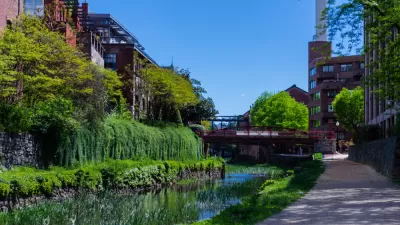Chuck Wolfe suggests we all have the inspiration within us to envision how to remake our cities--from the conjecture of a Seattle restauranteur about Seattle's monorail to neighborhood examples of "we used this before, let's use it again".
As part of a continuing series in Crosscut, Wolfe uses the foil of New York's High Line linear park to explain the role of vestiges of times gone by, beginning with a recent lunchtime suggestion by Seattle restauranteur Tom Douglas.
Douglas's suggestion? Abandon and green Seattle's monorail tracks--in the spirit of the High Line-- and provide walkable restaurant destinations along the way.
Drawing from landscape essayist J.B. Jackson, as well as his own book, Wolfe references the role of leftover structures in cities, and how, according to Jackson, they inspire us "to restore the world around us to something like its former beauty."
He notes other urban rails-to-trails examples--former land uses and infrastructure that have become, intentionally or otherwise, "eerily similar" to what transit and walkability advocates call for today. In merging former rail lines and current bike and pedestrian paths, these examples "illustrate firsthand Jackson's reasons for championing accessible, nostalgic vestiges of an urban past".
Wolfe concludes:
As Jackson noted, "Ruins provide the incentive for restoration, and for a return to origins." So too, they inspire Tom Douglas, and maybe you, to find your own "High Line.” Which is often just next door.
FULL STORY: Urban Ruins: Does Seattle need a High Line?

Study: Maui’s Plan to Convert Vacation Rentals to Long-Term Housing Could Cause Nearly $1 Billion Economic Loss
The plan would reduce visitor accommodation by 25,% resulting in 1,900 jobs lost.

North Texas Transit Leaders Tout Benefits of TOD for Growing Region
At a summit focused on transit-oriented development, policymakers discussed how North Texas’ expanded light rail system can serve as a tool for economic growth.

Why Should We Subsidize Public Transportation?
Many public transit agencies face financial stress due to rising costs, declining fare revenue, and declining subsidies. Transit advocates must provide a strong business case for increasing public transit funding.

How to Make US Trains Faster
Changes to boarding platforms and a switch to electric trains could improve U.S. passenger rail service without the added cost of high-speed rail.

Columbia’s Revitalized ‘Loop’ Is a Hub for Local Entrepreneurs
A focus on small businesses is helping a commercial corridor in Columbia, Missouri thrive.

Invasive Insect Threatens Minnesota’s Ash Forests
The Emerald Ash Borer is a rapidly spreading invasive pest threatening Minnesota’s ash trees, and homeowners are encouraged to plant diverse replacement species, avoid moving ash firewood, and monitor for signs of infestation.
Urban Design for Planners 1: Software Tools
This six-course series explores essential urban design concepts using open source software and equips planners with the tools they need to participate fully in the urban design process.
Planning for Universal Design
Learn the tools for implementing Universal Design in planning regulations.
City of Santa Clarita
Ascent Environmental
Institute for Housing and Urban Development Studies (IHS)
City of Grandview
Harvard GSD Executive Education
Toledo-Lucas County Plan Commissions
Salt Lake City
NYU Wagner Graduate School of Public Service




























